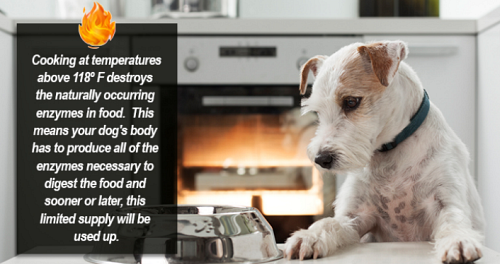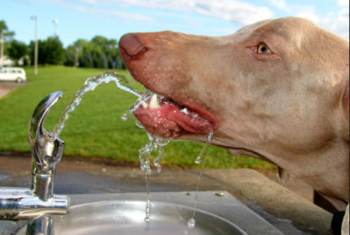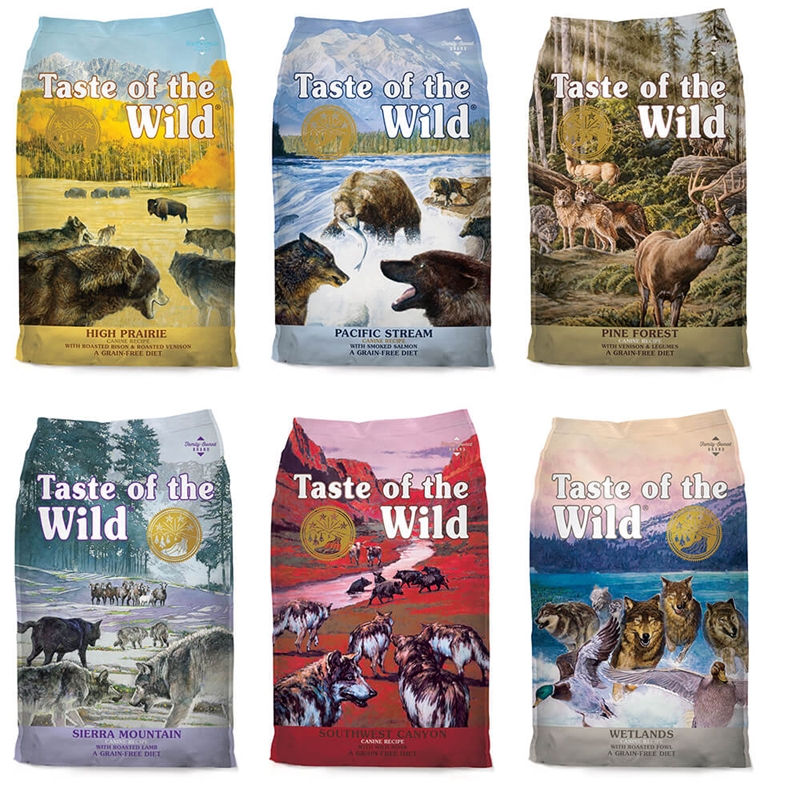What's Missing In Your Dog's Diet?
The food you feed your dog can make it thrive or merely survive
Is Your Dog Missing Vital Nutrients? | Is your dog merely surviving or is he thriving?
Live enzymes | What are digestive enzymes? | Enzyme deficiency
Enzymes in the diet | Supplementing with enzymes | Vitamins and minerals | Unaltered high quality protein | How do you know what’s in your dog’s food and where is it coming from? | The tip of the iceberg | Enter the premix | Made in the USA
What you can do? | Who’s watching the hen house? | Water

Is Your Dog Missing Vital Nutrients?
In this week's tip, you'll see there are certain key nutrients many dog foods are lacking ... and learn how this will ultimately cause premature aging and chronic disease.
Cutting corners on your pet's food bill today will only cost you money (and heartache) tomorrow ... so check out the four major items you need to look for in your dog's food.
Nutritional deficiencies are robbing dogs of their health and vitality, causing them to wear down faster than they should ... so check our list out now:
Is your dog merely surviving or is he thriving?
Some dog owners believe their dog is completely healthy on a kibble diet, but there are some important nutrients that are not yet deemed essential under the official nutritional guidelines for pet foods. Young animals can appear to be full of life and the picture of health but what is going on inside their bodies as they grow, mature and reach their senior years?
As dogs age, their owners may find they just don't have the same vitality they once did. It's often attributed to getting older but it could be a sign of nutritional deficiencies in the diet that are not yet fully understood. Below are some nutrients that are found in a properly balanced raw diet but are often missing from commercially prepared pet foods. Don't leave these important nutrients out!
Live enzymes
Enzymes are biological molecules responsible for every metabolic reaction that takes place in your dog's body, whether it is the blinking of his or her eyes or the functioning of their livers. Put simply "They help sustain and support your dog's life."
Most enzymes are proteins that act as catalysts for thousands of metabolic reactions in the canine body and help maintain homeostasis. If there's a mutation, change or termination in production, disease can occur.
When mammals are born, their cells are programmed to produce a certain amount of enzymes within their lifetime. The rest must be obtained from food. When the body is burdened by the job of producing every enzyme, it becomes deficient and vulnerable to disease and dysfunction. Glands and major organs suffer from enzyme deficiency. This often becomes more apparent as dogs age and lose vitality.

What are digestive enzymes?
Enzymes are life and when your dog is out of enzymes, he is out of life.
The body also uses enzymes to digest and use food. There are two types of enzymes that do that:
- Enzymes in the food itself, and
- Enzymes that reside in the digestive organs
The body can't produce a finite supply of enzymes – like a bank account, if you continuously make withdrawals without depositing money, you will soon be broke.
This is what happens when dogs eat processed pet foods. Cooking at temperatures above 118 o F destroys the naturally occurring enzymes in food. This means your dog’s body has to produce all of the enzymes necessary to digest the food and sooner or later, this limited supply will be used up.
If the body is constantly producing enzymes for digestion, it can't produce the enzymes needed for maintaining healthy tissue and cleaning up toxins in the body. This places strain on the pancreas as it must be constantly producing digestive enzymes instead of its normal work as part of the immune system. This strain leads to ill health, chronic disease such as diabetes, arthritis and allergies, and a shortened lifespan.
Enzyme deficiency
Cooking food destroys live enzymes and can cause enzyme deficiency in your dog. Unfortunately, there's no easy way to diagnose enzyme deficiency since it affects each animal differently and can show up as any number of metabolic diseases.
There are tests for EPI (exocrine pancreatic insufficiency), which is usually genetically acquired. EPI is the pancreas's inability to synthesize and distribute digestive enzymes properly. Vets can also test certain enzyme levels in the blood but this is usually only done in severe cases. A low-grade enzyme deficiency may go unnoticed for many years.
A raw diet naturally provides enzymes that dogs have obtained during millions of years of evolutionary growth. Access to live enzymes allows the DNA of the cells to maintain its integrity.
If your pet can't eat a raw diet, it's a good idea to add a good quality digestive enzyme support supplement. Adding supplemental enzymes to the diet can improve digestion, metabolism, organ function, skin health, allergy symptoms and much more.
Enzymes in the diet
The best solution for enzyme deficiency is to feed your dog foods that already have an abundance of enzymes. Whereas processed foods are "dead", raw and whole foods have an abundance of enzymes. In order to function optimally, enzymes work in close association with vitamins and minerals. Vitamins and minerals will also be found in abundance in raw foods.
There are many foods that are high in naturally occurring enzymes. One of the best sources is raw, green tripe – it carries a host of digestive enzymes! Feeding whole prey animals, with the digestive system and organs intact, will also accomplish this. Fresh muscle meat is also a good source of enzymes.
Enzymes are used up faster during some illnesses, extremes in weather or strenuous exercise. Older dogs will also benefit from extra enzymes as the amount of enzymes produced in the body declines with age and this is partly responsible for age related illness and debilitation.
If a dog has spent most of his own enzymes and he isn't getting any in the diet, his cellular function and health will rapidly decline
Keep updated with all that's
right for your best friend!
click on this link
to subscribe to our free mailing list.
Supplementing with enzymes
Even raw fed dogs might not be getting enough enzymes in their diet, especially if they don't consume the entrails of their food (and most dogs don't). Supplementing with digestive enzymes may be a smart idea for many dogs. When shopping for a digestive enzyme, try to find one that's produced from animals, not plants.
Dogs who are getting enough digestive enzymes have better immune health, skin, coat, joints and teeth, and will do a better job of getting all of the nutrients out of their food. But remember, when they're gone, they're gone – so now is a great time to make sure your dog is getting enough enzymes in his diet!
Vitamins and minerals
Vitamins and minerals are not used or recognized properly without enzymes. All the pieces of the diet must be present to maintain your dog's health and vitality.
Most dry dog foods rely on synthetic vitamins and minerals for nutrition, so if you're feeding kibble, your dog may not be getting the sustenance he needs for health. Ideally, your dog's nutrition should come from whole, fresh foods, but when supplementation is needed, always look for natural supplements derived from food, rather than synthetic products.
Synthetic vitamins and minerals are "isolated" in a laboratory. They lack the cofactors and transporters found in naturally occurring vitamins.
The Organic Consumers Organisation recognises this and emphasises that synthetic vitamins are not recognized and utilized by cells in the same manner as their naturally occurring counterparts.
Each natural-source vitamin has its own unique profile within the food that is eaten, e.g. the enzymes and minerals that accompany it help the body absorb it.
Unaltered high quality protein
Your dog’s health will be reflected in the quality of proteins he eats.
Proteins found in meat by-products (not approved for human consumption) are not the same quality as fresh, unaltered, lean, human grade meats. If you wouldn't eat it, why feed it to your pet?

Also, cooked meats lack live enzymes that allow your dog to absorb the nutrients in his food.
Dry dog food ingredients are usually processed at very high temperatures. If it's cheaper in price, there's a reason.
Cutting corners on quality could cost your pet his health, which won't be cheaper in the end.
Providing fresh, high quality foods is the best pet insurance you can buy for your dog.
How do you know what’s in your dog’s food and where is it coming from?
Think you can avoid pet foods made in China? Think again!
Hundreds of consumer complaints were aimed at US dog food manufactures in 2012 and dozens – perhaps hundreds – of dogs were harmed. While many of these tainted jerky treats have been recalled, these most recent recalls are likely just another case of Chinese imports.
Fortunately, pet owners have become wiser since the melamine poisonings and massive recalls from 2007, and many are making decisions that will protect their pets.
They have learned that quality control and food safety standards are shabby at best in many overseas and Chinese manufacturing plants and that even in the US, manufacturers have few safety and testing requirements.
Pet owners are wisely avoiding treats and foods made in China and that's good. But despite avoiding these products, their dogs continue to die and become ill. How can this happen when the food label says "made in the USA"?
The tip of the iceberg
The label on your pet food or treat may conceal a little lie – and this lie could cost your pet his health or even his life.
There is something inherently wrong with most processed foods that pet owners are unaware of. The heating and processing that these foods undergo create a fundamental change that could have dangerous ramifications – it renders the food essentially dead.
What goes into the good is not what comes out once it is heated, sterilized, irradiated and extruded and nearly all dog foods will not meet the Association of American Feed Control Officials (AFCO) standards once they are heated. As a consequence, the vitamins and minerals must be added back in for the food to pass AAFCO requirements.
Enter the premix
Back in 2007, the melamine that was poisoning dogs and cats was not added directly to the pet foods – it was found in the premix. The Chinese manufacturers added it to their premix to boost the protein content as cheaply as possible. Only when dogs and cats started dying – and the FDA was forced to begin testing the foods – did anyone become aware of the fact.
What made the recall so large was that it wasn't limited to a single food manufacturer, because they nearly all rely on premixes, and therefore a large number of pet food manufacturers were affected.
What this means, is that switching your pet from one food to another wont necessarily mean that you will make any difference at all, because odds are your new food manufacturer purchases exactly the same premix.

How do you know if your food contains premix?
Look at the label.
On the right is a label from what many people consider a high-end kibble dried food.
See those vitamins, minerals and long chemical names that are listed at the bottom? Those very likely came from a premix and that premix was very likely manufactured overseas.
If the premix is not added to the food, your dog would become ill and under-nourished from eating the nutritionally dead contents. If the premix is added to the food, you are relying on foreign safety standards and are essentially playing roulette with your dog's health.
Compare that label to the ingredients of a quality, commercial food: Lamb meat, lamb bone, lamb blood, eggs, lamb green tripe, lamb liver, broccoli, cauliflower, carrot, silver beet (spinach), cabbage, apples, pears, lamb hearts, lamb kidneys and garlic.
Which food do you think is safer for your pet?
Made in the USA
Click here for a list of the world's top ten dog food manufacturers. All are very recognisable brand names in the US, Canada, the UK and Europe, and in Australia and New Zealand. Most brands are either exported to these countries from the US, or made and sold under license agreements with imported ingredients from the US.
If you have made the phone call and found out that your pet food's premix has been manufactured in the US, don’t start feeling all warm and fuzzy just yet. The individual synthetic vitamins and minerals that are in that made-in-the-US premix are almost all manufactured in India or China, so it may or may not be a safe option after all.
At the end of the day, some pet food manufacturers do their best to source out the safest premixes possible – but it is difficult for them to determine where the individual ingredients originated from, and what quality control measures were put in place.
Who’s watching the hen house?
The million dollar question is, if pet food manufacturers can't prove the origin of their premixes, why don't they test every batch of food? The answer might shock you! It is so cost prohibitive that it is actually cheaper for them to pay the lawsuits from our dead pets than it is to test their product.
In January 2011, the FDA finally stepped in with their Food Safety Modernization Act (FSMA) Some provisions took effect immediately but to date have had a minimal impact on most pet food manufacturers.
The FSMA provisions already in effect include emergency FDA access to a company’s records and mandatory recall authority for the FDA if a company refuses to voluntarily recall a product.
The agency also has to find “reasonable probability” the product is adulterated and that consumption of the food will cause serious adverse health consequences or death.
As part of FSMA’s "Foreign Supplier Verification Program", every importer must establish a plan that verifies the foreign supplier complies with a hazard analysis and preventive controls program.
It remains to be seen how much influence the FSMA will have on pet food manufacturers but, as of today, nothing much has been done yet. Because the FSMA also applies to human foods and food-animal feeds, it remains to be seen how much time and effort will be spent inspecting pet foods in the years to come.
What you can do?
In the meantime, it is most likely safe to assume that virtually nobody is actively protecting your pet from poisoned pet foods.
Providing a balanced home prepared diet of raw, fresh foods is the easiest way to be sure your dog is getting the officially “essential” nutrients as well as those that may be missing.
All nutrients found in food are essential to life or they wouldn't be there. Mother Nature is a highly organised and efficiently-run system that allows all creatures and plants to thrive in their environment.
We can't deny our dogs access to this system without disrupting the natural order in which they function. Consult with your holistic vet or a pet nutritionist to make sure you're providing all the dietary components your dog needs to flourish
Water
Is your pet thirsty? the most common symptoms of dehydration are: 
- Sunken eyes
- Lethargy
- Loss of appetite
- Dry mouth, which can lead to bad breath
- Depression
Thirst is the product of dehydration. Long term systemic dehydration can cause devastating health problems including metabolic kidney and liver diseases.
After eating dry food, a dog becomes dehydrated and thirsty, and then needs to drink water to replenish fluid in and around the cells. It requires energy and time for the cells to rebalance. This puts unnecessary stress on the entire organism.
Fresh foods have a moisture content of 70 to 80 percent, which protects homeostasis from the stress of dehydration. This allows the animal to keep water evenly distributed throughout the body at all times, not just sometimes. Don't forget that water is actually the most important nutrient of all. If it occurs naturally in food, there's a reason!
Reference: Dogs Naturally
Images: Dogs Naturally
Images: www.swaggerbout.com.au
Images: www.leftovernachos.com
This article and information forms part of the Carole's Doggie World Holistic Library and is presented for informational purposes only.The information is not intended to be a substitute for visits to your local vet. Instead, the content offers the reader information researched and written by Carole Curtis for www.carolesdoggieworld.com







